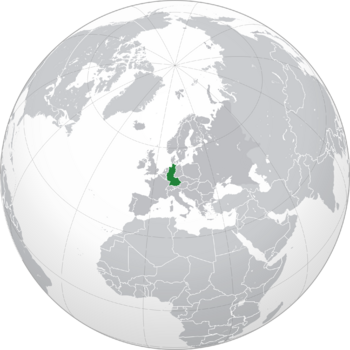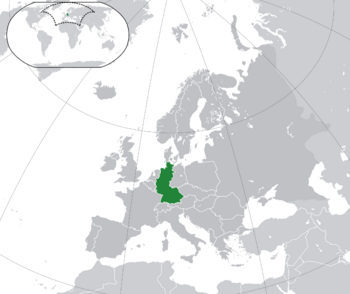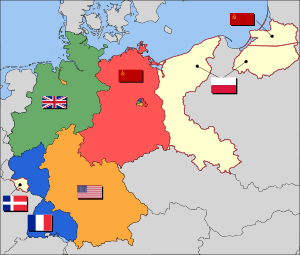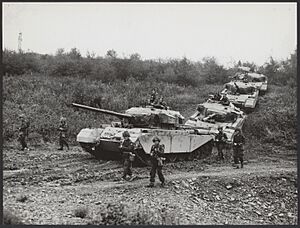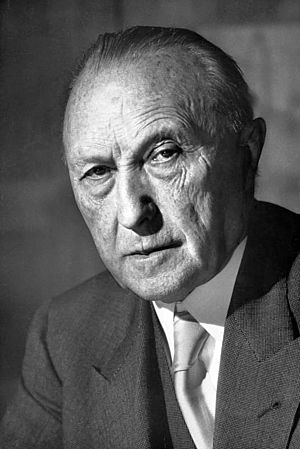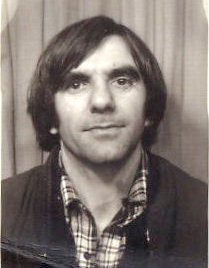West Germany facts for kids
Quick facts for kids
Federal Republic of Germany
Bundesrepublik Deutschland (German)
|
|||||||||||||||
|---|---|---|---|---|---|---|---|---|---|---|---|---|---|---|---|
| 1949–1990(g) | |||||||||||||||
|
|
|||||||||||||||
|
Motto: Gott mit uns
"God with us" (1949–1962) Einigkeit und Recht und Freiheit "Unity and Justice and Freedom" (since 1962) |
|||||||||||||||
|
Anthem:
Ich hab mich ergeben "I have surrendered myself" (unofficial, 1949–1952) |
|||||||||||||||
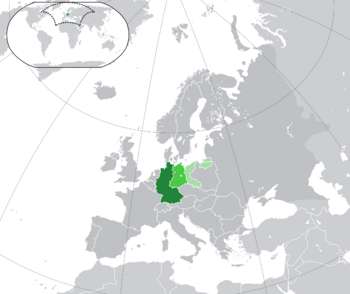 Territory of West Germany Lands of the German Democratic Republic (East Germany), claimed by West Germany until 1973 Lands of pre-1937 Germany that were annexed by Poland and the Soviet Union after World War II, claimed by West Germany until 1972
Territory of West Germany Lands of the German Democratic Republic (East Germany), claimed by West Germany until 1973 Lands of pre-1937 Germany that were annexed by Poland and the Soviet Union after World War II, claimed by West Germany until 1972Show territorial claims |
|||||||||||||||
| Capital | Bonn(f) | ||||||||||||||
| Largest city | Hamburg | ||||||||||||||
| Official languages | German | ||||||||||||||
| Religion | See Religion in West Germany | ||||||||||||||
| Demonym(s) |
|
||||||||||||||
| Government | Federal parliamentary republic | ||||||||||||||
| President | |||||||||||||||
|
• 1949–1959 (first)
|
Theodor Heuss | ||||||||||||||
|
• 1984–1990 (last)
|
Richard von Weizsäcker(b) | ||||||||||||||
| Chancellor | |||||||||||||||
|
• 1949–1963 (first)
|
Konrad Adenauer | ||||||||||||||
|
• 1982–1990 (last)
|
Helmut Kohlc | ||||||||||||||
| Legislature | Bicameralism | ||||||||||||||
| Bundesrat | |||||||||||||||
| Bundestag | |||||||||||||||
| Historical era | Cold War | ||||||||||||||
| 23 May 1949 | |||||||||||||||
|
• Bonn–Paris conventions
|
5 May 1955 | ||||||||||||||
|
• Member of NATO
|
9 May 1955 | ||||||||||||||
|
• Saar statute
|
1 January 1957 | ||||||||||||||
|
• Creation of EEC
|
25 March 1957 | ||||||||||||||
|
• Basic Treaty with the GDR
|
21 December 1972 | ||||||||||||||
|
• Admitted to the UN
|
18 September 1973 | ||||||||||||||
| 12 September 1990 | |||||||||||||||
| 3 October 1990(g) | |||||||||||||||
| Area | |||||||||||||||
|
• Total
|
248,717 km2 (96,030 sq mi) | ||||||||||||||
| Population | |||||||||||||||
|
• 1950(d)
|
50,958,000 | ||||||||||||||
|
• 1970
|
61,001,000 | ||||||||||||||
|
• 1990
|
63,254,000 | ||||||||||||||
|
• Density
|
254/km2 (657.9/sq mi) | ||||||||||||||
| GDP (PPP) | 1990 estimate | ||||||||||||||
|
• Total
|
~$1.0 trillion (4th) | ||||||||||||||
| Currency | Deutsche Mark(e) (DM) (DEM) | ||||||||||||||
| Time zone | UTC+1 (CET) | ||||||||||||||
|
• Summer (DST)
|
UTC+2 (CEST) | ||||||||||||||
| Calling code | +49 | ||||||||||||||
| Internet TLD | .de | ||||||||||||||
|
|||||||||||||||
| Today part of | Germany | ||||||||||||||
|
|||||||||||||||
West Germany was the common name for the Federal Republic of Germany from 1949 to 1990. Its capital city was Bonn. During the Cold War, West Germany was part of the Western Bloc, which included countries allied with the United States.
West Germany was created after World War II from parts of Germany that were controlled by the United States, the United Kingdom, and France. It had 12 different states. Later, three of these states joined to form Baden-Württemberg in 1952. The Saarland also joined West Germany in 1957, becoming another state.
West Germany grew very quickly after the war. This period was known as the "economic miracle" (Wirtschaftswunder). It became one of the world's strongest economies. The first leader, Konrad Adenauer, helped West Germany join NATO, a military alliance. He also supported agreements that led to the creation of the European Union.
After the Berlin Wall came down in 1989, West Germany and East Germany worked to become one country again. East Germany joined West Germany in 1990. This event is called German reunification. The united Germany continued as the Federal Republic of Germany, just bigger.
Contents
Understanding West Germany's Name
Before Germany became one country again, it was split into two main parts. These were the Bundesrepublik Deutschland (Federal Republic of Germany), known as West Germany, and the Deutsche Demokratische Republik (German Democratic Republic), known as East Germany.
When East Germany joined West Germany, the official name for the united country remained Bundesrepublik Deutschland. This showed that West Germany was expanding, not creating a brand new country.
In East Germany, people often used terms like Westdeutschland (West Germany) or westdeutsche Bundesrepublik (West German Federal Republic). They also started using the short form BRD for West Germany.
However, West Germany itself preferred to use its full name, Federal Republic of Germany, in official documents. They wanted to avoid the short form BRD.
The international country code for West Germany was DE, which is still used for Germany today. This code is used for things like internet addresses (like .de).
West Germany's History
After World War II ended in 1945, leaders from the United States, the United Kingdom, and the Soviet Union met to decide Germany's future. They agreed to divide Germany into four areas, called occupation zones. These zones were for administration, not to permanently split the country.
- A French Zone in the far west.
- A British Zone in the northwest.
- An American Zone in the south.
- A Soviet Zone in the East.
The city of Berlin was also divided into four zones.
Later, the British and American zones combined to form "Bizonia." Then the French zone joined, creating "Trizonia." The Soviet zone became East Germany.
Many Germans who had been forced to leave their homes in other parts of Europe after the war settled in West Germany. About eight million German refugees found new homes there.
In 1949, as the Cold War began, the two German states officially formed. The areas controlled by the Western Allies became West Germany. The Soviet-controlled area became East Germany.
In 1990, West and East Germany signed an agreement to end their separate status. This agreement also confirmed Germany's borders after the war. On October 3, 1990, East Germany joined the Federal Republic, ending the division.
Joining NATO
West Germany was officially founded on May 23, 1949. It gained full control over its own affairs on May 5, 1955. The Western troops who had occupied Germany stayed in the country, but now as part of NATO. West Germany officially joined NATO on May 9, 1955.
West Germany became a key area in the Cold War because it bordered East Germany, which was part of the Warsaw Pact (the Soviet Union's military alliance). Berlin, the former capital, was also divided. West Berlin was surrounded by East German territory, and the Soviets had even tried to block access to it in 1948–49.
The Korean War in 1950 made the U.S. think that West Germany needed its own army to help defend Western Europe. There were ideas to create a European army, but this plan didn't work out. Instead, West Germany was allowed to rearm and form its own military, called the Bundeswehr. This army was under West German control, but its size was regulated by the Western European Union.
Changes in the 1960s
Konrad Adenauer was West Germany's first chancellor. He led the country for 14 years, from 1949 to 1963. He was very important in shaping West Germany's early years.
In 1962, a news magazine called Der Spiegel published an article about weaknesses in West Germany's military. This caused a big stir. The government raided the magazine's offices, and the editor was even jailed for a short time. This led to public protests about freedom of the press. The defense minister had to resign, and Adenauer announced he would step down in 1963.
In the early 1960s, West Germany's fast economic growth started to slow down. To deal with this, a new government was formed in 1966, led by Kurt Georg Kiesinger. This government introduced new "emergency acts" that allowed some basic rights to be limited during a crisis.
Many students and other groups strongly opposed these new laws. Students also wanted to learn more about their parents' generation during the Nazi era. Trials of former concentration camp guards in Frankfurt in 1963 helped reveal the truth about the terrible crimes committed during that time.
This period led to many discussions about important topics like equality, the environment, and democracy. In 1979, the Green Party, focused on environmental issues, won seats in a local election. A strong feminist movement also grew, fighting for equal rights for women. Until 1977, a married woman needed her husband's permission to get a job or open a bank account. These laws were changed to give women equal rights.
Some groups, frustrated with the slow pace of change, became more extreme. The Red Army Faction was one such group. They committed acts of violence, but eventually stopped their activities in 1998.
Willy Brandt's New Policies
In 1969, Willy Brandt became chancellor. He kept West Germany close to the United States and worked to strengthen cooperation in Western Europe. He also started a new policy called Ostpolitik. This policy aimed to improve relations with countries in Eastern Europe, including East Germany.
Brandt was known for his strong stance against communism at home. He also supported American policies, even during the Vietnam War. In 1970, during a visit to a memorial in Poland, Brandt famously knelt in silence. This act, known as the Kniefall von Warschau, showed deep respect and sorrow for the victims of World War II.
Brandt resigned in 1974 after it was discovered that one of his close assistants was a spy for East Germany's secret service.
Helmut Schmidt's Leadership
Helmut Schmidt became chancellor in 1974 and served until 1982. He was a strong supporter of the European Community and the alliance with the United States. Schmidt focused on foreign policy because of many international challenges.
He worked with the French President to create the European Monetary System in 1978. This system helped stabilize currencies in Europe.
Helmut Kohl and Reunification
In 1982, Helmut Kohl became chancellor. He led a government that included his party, the CDU/CSU, and the FDP. In the 1987 elections, Kohl's government was re-elected. The Green Party also gained more support during this time.
When the Berlin Wall opened in 1989 and the Soviet Bloc began to collapse, there was a quick move towards German reunification. After democratic elections, East Germany decided to join the Federal Republic of Germany.
Both West and East Germany changed their laws to make this happen. East Germany then dissolved itself, and its five states, along with a reunited Berlin, officially joined the Federal Republic on October 3, 1990. This increased the number of states in Germany from 10 to 16 and ended the division.
The united Germany kept West Germany's political system and its memberships in international groups like NATO and the European Union. The official reunification ceremony took place at the Reichstag building in Berlin.
Later, in 1991, the German parliament decided that the government and parliament should move from Bonn to Berlin, making Berlin the capital of the united Germany.
See also
 In Spanish: Alemania Occidental para niños
In Spanish: Alemania Occidental para niños
- History of Germany (1945–1990)
- Inner German relations
- Economic history of the German reunification
- Petersberg Agreement




